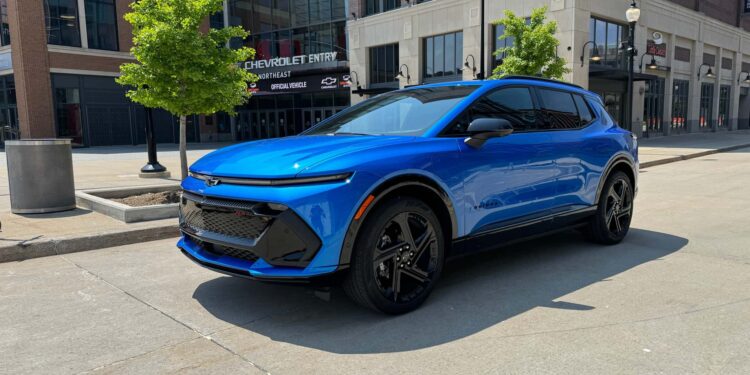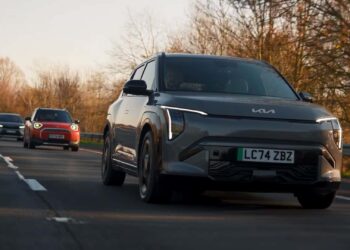Despite some hiccups in their plans, Hyundai and General Motors are charging ahead with their lofty electrification goals. Their entry-level electric SUVs, the Ioniq 5 and Chevrolet Equinox EV, offer generous tech features, serviceable driving ranges, and excellent safety features, making them solid options in their segment. Though very similar, key differences between the two deserve a deeper dive. The Ioniq 5 has been on sale for a few years, but the Chevy is brand-new for 2024, so let’s take a closer look at how the pair stacks up.
2024 Chevrolet Equinox EV vs. 2024 Hyundai Ioniq 5: Price
The Chevrolet Equinox EV isn’t as cheap as the automaker originally advertised, but it’s still one of the more affordable models on sale today. Pricing starts at $43,295 for the current base 2LT FWD variant, which includes a $1,395 destination charge. The base 2024 Hyundai Ioniq 5 SE Standard Range checks in at $100 less after a $1,395 destination charge. It’s also worth pointing out that the Equinox EV is eligible for a $7,500 tax credit, whereas the Ioniq 5 is not because of its foreign build location and battery materials sources.
Neither model is particularly affordable at the top end of their respective lineups, but the Chevy undercuts the Hyundai by a notable margin. The top Chevrolet Equinox EV 3RS AWD trim starts at $50,095, while the Ioniq 5 reaches $54,895 in its top Limited configuration. That said, the separate Ioniq 5 N performance model is significantly more expensive. Chevy buyers can add thousands to the price of the Equinox EV with options and accessories, but Hyundai keeps things simple with few accessories, and all-wheel drive is the only option, costing $3,900.
2024 Chevrolet Equinox EV vs. 2024 Hyundai Ioniq 5: Range
The longest-range Ioniq 5 tops out at 303 miles, but all-wheel drive knocks that number down to 260 miles. Impressively, Chevy estimates a 319-mile range for the Equinox EV with front-drive and 285 miles with all-wheel drive. Real-world range results depend heavily on several factors, including the driving style, temperature, and more.
Charging the Equinox EV takes around nine hours using a Level 2 240-volt charger. Things speed up considerably with a Level 3 DC fast charger, with the vehicle able to reach a full charge in around 40 minutes. The Ioniq 5 takes six hours to charge from ten to 100 percent on a 240-volt outlet, though more expensive configurations take about an hour longer to reach a full charge. Using DC fast charging, the EV can go from ten to 80 percent in under 20 minutes.
| Model | Drive | Battery (kWh) | EPA Range | 0-60 mph (sec) |
| 2024 Chevrolet Equinox EV FWD | FWD | 85 | 319 mi | 7.9 |
| 2024 Chevrolet Equinox EV AWD | AWD | 85 | 285 mi | 5.9 |
| 2024 Hyundai Ioniq 5 Standard Range | RWD | 58.2 | 220 mi | |
| 2024 Hyundai Ioniq 5 Long Range RWD | RWD | 77 | 303 mi | |
| 2024 Hyundai Ioniq 5 Long Range AWD | AWD | 77 | 260 mi | 5.0 |
| 2024 Hyundai Ioniq 5 N | AWD | 84 | 221 mi | 3.0 |
2024 Chevrolet Equinox EV vs. 2024 Hyundai Ioniq 5: Efficiency
The Hyundai Ioniq 5’s most efficient configuration is the base trim with rear-wheel drive and long-range battery. It achieves an EPA-estimated 114 MPGe combined, while the standard-range variant reaches 110 MPGe. The long-range all-wheel drive model tops out at 99 MPGe.
The Equinox EV isn’t as efficient as the Hyundai. Its most frugal format is the base front-drive model, which reaches 108 MPGe combined. Adding all-wheel drive pushes efficiency down to 96 MPGe.
2024 Chevrolet Equinox EV vs. 2024 Hyundai Ioniq 5: Charge Time
Both SUVs are capable of fast charging using a Level 3 station. The Ioniq 5 takes around 18 minutes to charge from ten to 80 percent on a 350 kW charger, while Chevrolet states that the Equinox EV takes 40 minutes to reach a full charge on a Level 3 charger. Keep in mind that there are a variety of factors that impact charging speeds, including the charger itself and the vehicle’s ability to accept those speeds.
Level 3 chargers have a huge range of charging speeds, from 50 kW to 500 kW, so there’s a big difference between charging stations in some cases. And while the Equinox can technically accept 150 kW and charge in 40 minutes, you’re unlikely to see that sort of charging speed or power from a 150-kW charger. The Equinox has a low pack voltage when charge is low, so it takes a lot of current to reach 150 kW. Most 150 kW stations can’t provide what it needs, so you’ll need a more powerful charger to get from 10-80 in 40 minutes. Hyundai’s 800-volt architecture means the Ioniq 5 is a more consistently quick charger. Both EVs have battery conditioning systems that help ensure the ideal charging temperatures for faster speeds.
2024 Chevrolet Equinox EV vs. 2024 Hyundai Ioniq 5: 0-60 MPH
While EVs are known for delivering thrilling acceleration and low 0-60 mph times, neither of these sedate vehicles is particularly exciting to drive. The all-wheel drive Ioniq 5 is quicker, however, reaching 60 mph from a standstill in around 5 seconds in the more powerful all-wheel drive configuration. The quickest Equinox EV takes around six seconds to reach 60 mph. It’s worth noting that Hyundai offers a much hotter Ioniq 5 N, which can hit 60 mph in just over three seconds.
2024 Chevrolet Equinox EV vs. 2024 Hyundai Ioniq 5: Top Speed
While these two EVs are more than capable of breaking any legal speed limit in the U.S., they both have modest, electronically limited top speeds. The Equinox EV tops out at 113 mph, while the Ioniq 5 can reach 115 mph. Driving anywhere near their top speeds greatly reduces their range and efficiency, which is also true at highway speeds. Electric vehicles do not deliver their best range and efficiency numbers at higher speeds, returning better figures around town in stop-and-go traffic.
2024 Chevrolet Equinox EV vs. 2024 Hyundai Ioniq 5: Driver-Assistance Systems
The Hyundai Ioniq 5 comes well-equipped from the factory, offering several standard driver assistance features. The list includes forward collision warnings, adaptive cruise control, automatic emergency braking, pedestrian detection, blind spot monitoring with rear cross-traffic alerts, traffic sign recognition, rear parking sensors, automatic high beams, rear-seat alerts, driver attention warnings, lane keep assist, lane departure alerts, and safe exit warnings. Higher trims add a head-up display, front parking sensors, a blind spot camera system, rain-sensing wipers, and a surround-view camera system. The 2024 Ioniq 5 earned an IIHS Top Safety Pick + designation.
Chevy also equips the Equinox EV with plenty of safety gear, including blind spot monitoring with rear cross-traffic alerts, forward and reverse automatic emergency braking, pedestrian and cyclist detection, a surround-view camera, traffic sign recognition, rear-seat alerts, adaptive cruise control, lane keep assist, lane departure warnings, a safety alert seat system, automatic high beams, buckle-to-drive, and a teen driver mode that lets parents set limits on vehicle speed and other criteria. Neither the IIHS nor the NHTSA have evaluated the Equinox EV.
2024 Chevrolet Equinox EV vs. 2024 Hyundai Ioniq 5: Interior
The Equinox EV’s interior feels, well, like a Chevy. The SUV is well laid out, has physical buttons, and offers a good amount of passenger space. Synthetic leather comes standard, along with heated front seats and a heated steering wheel. Power-adjustable front seats are also standard, with eight-way movement on the driver’s side. More expensive configurations get a six-way power-adjustable front passenger seat, heated rear outboard seats, ventilated front seats, and a memory system for the driver’s seat. Standard tech features include an 11-inch digital gauge cluster, a 17.7-inch touchscreen, voice commands, LED ambient interior lighting, SiriusXM, and Bluetooth.
Hyundai equips the five-seat Ioniq 5 with cloth upholstery and manual, heated front seat adjustments as standard. Higher trims add synthetic leather, power-adjustable front seats, ventilated seats, a heated steering wheel, and more. A 12.3-inch touchscreen and 12.3-inch digital gauge cluster display are standard, along with HD radio, SiriusXM, Apple CarPlay and Android Auto, navigation, five USB ports, dual-zone automatic climate controls, and more.
The Ioniq 5’s cabin feels more modern than the Equinox EV’s. Part of that is due to the parts-sharing General Motors employs across some product lines. The Chevy’s climate controls and other features are very similar to its gas vehicles, such as the Colorado pickup truck, which has physical climate control buttons identical to the Equinox EV’s.
2024 Chevrolet Equinox EV vs. 2024 Hyundai Ioniq 5: Build Quality
Hyundai and Chevy’s build quality has improved over the years, though the Ioniq 5 feels and looks more upscale than the Equinox EV. Both are well screwed together, and neither exhibits many stray rattles or creaking inside. That said, the pair has cheap plastics and low-rent materials in places, though higher trims project more luxury, with nicer finishes throughout their cabins.
2024 Chevrolet Equinox EV vs. 2024 Hyundai Ioniq 5: Driving Dynamics and Ride Comfort
The new Equinox EV’s comfort tuning yields a mostly smooth ride, but the tradeoff is a too-light steering feel that offers very little feedback about what’s going on under the front wheels. Despite that, the SUV has a planted driving feel, and its brakes are confidence-inspiring in most situations. The Ioniq 5 has slightly more athletic handling but retains a decent ride quality on rougher roads. Its braking feel is linear, with little of the “grabby” feel that some vehicles exhibit.
2024 Chevrolet Equinox EV vs. 2024 Hyundai Ioniq 5: Conclusion
The Chevrolet Equinox EV and Hyundai Ioniq 5 are both great entry-level electric SUVs, though it’s hard to lean too hard on the “entry-level” wording because of their stout starting price tags. That said, their driving range estimates, generous standard features, and reasonable performance make them compelling alternatives to comparable gas vehicles, and the Chevy’s tax credit eligibility significantly reduces the cost of entry.
What Our Experts Say
I haven’t driven the Equinox EV—I will in a few weeks—but I did lease a Blazer EV, which shares a lot with the Equinox. GM’s software suite is the same in both cars. I find it far superior to the Hyundai’s. Built-in Google Assistant and Google Maps mean I don’t miss Apple CarPlay, and the graphics are slicker than in the Ioniq 5. There are also better physical controls for key climate functions, while the Ioniq 5 has more capacitive buttons.
Though I prefer the interior and software of the Equinox EV to the Ioniq 5, the Hyundai’s the better pick if you’re a frequent road-tripper. Real-world charging speeds for the Blazer—which shares its battery pack with the Equinox—have not been impressive. The car needs an ultra-fast charger to deliver so-so charging speeds. It’s fine for the occasional long trip, and will be better when the Equinox gets access to Tesla Superchargers, but for now it’s the weakest point of these otherwise great SUVs. — Mack Hogan, Deputy Editor










